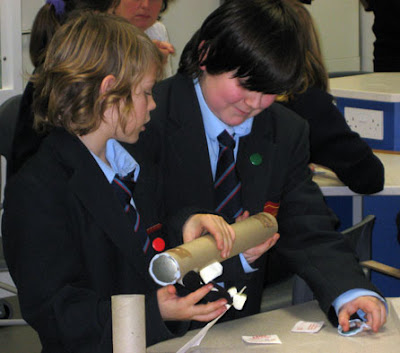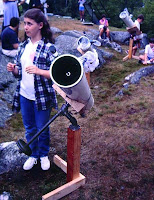
 by John B. Mayall
by John B. Mayall
In today's age, a person is able to buy a telescope, readymade, from the market. But for one who is not experienced, constructing a telescope is akin to an adventure. Although the procedure is complex and technical, and quite long, it is quite possible to make a telescope for oneself, by oneself. For the amateur who holds a keen interest in the telescope and the way it works, constructing it by oneself can be quite adventurous and fulfilling.
The construction itself is not very difficult, and it is made easier if one can enlist the assistance of another person who has himself constructed telescopes earlier. Even someone who is an amateur astronomer would make a good mentor, if it's no possible to find one experience in telescope construction. Astronomy clubs generally have at least one member who has prior experience of building telescopes, and such people are quite accommodating towards amateurs.
For an amateur, telescope construction can be a cumbersome task. Patience and calm are advisable for a first-timer. The greatest inventions of all time came from blind experiments and unexpected results. When starting out, it is always best to have some references and manuals handy, as they can explain the technical aspects in the clearest ways. A local library is a good source for material to an amateur just starting out in telescope building.
The basic elements of a telescope are the mirror, two lenses, the housing for the whole structure, and materials that will be used for polishing the mirror. These parts can all be bought at local stores or even online. The mirror can be ground at home as well, but is a tiresome process.
The construction of a telescope is a long and drawn out process. Careful planning is required to ensure that there is minimal cleaning up left after all the work is completed. Is advisable to lay out newspapers to ensure clean work as well as to ensure correct placement of all the equipment. Maintain a logbook if possible to keep track of the task completed and the duration of each task. In later stages, the logbook is a good record to refer to understand the tasks completed and how long each task required. Also, it helps one to remember what work has been completed and what remains.
Once the construction is complete, it is quite natural for the amateur to be pleased with himself for the work he has accomplished. It is however, easier to buy a telescope kit from the market instead of purchasing individual component and constructing the whole structure. Assembling a telescope from a kit is easier, takes less time and is a better financial option. Such telescope kits are intended for the amateurs, and not directed at the professionals.
Get free lessons on how to build a telescope as well as professional advice on how to buy a telescope when you visit http://www.howdotelescopeswork.com, the premier portal on how to use telescopes.
Step-by-Step Guide to Increase IQ













